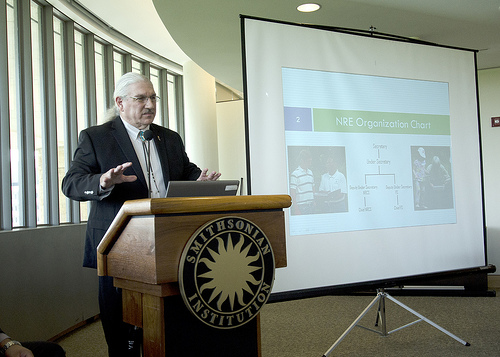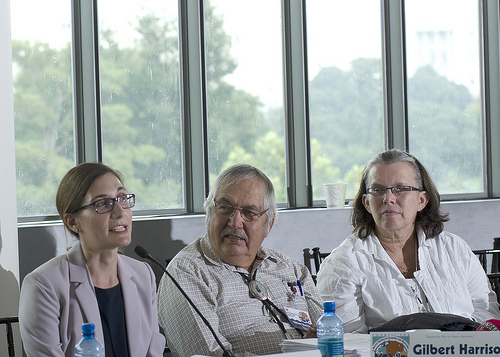Council for Native American Farming and Ranching Begins Work

Natural Resources/Range Manager of the Shoshone-Bannock Tribes in Blackfoot, ID., Mark Wadsworth, speaking, was voted Chairman of the U.S. Department of Agriculture’s (USDA) Council for Native American Farming and Ranching (CNAFR) held at the National Museum of the American Indian in Washington, D.C., on Wednesday, Aug. 15, 2012. CNAFR was created to advise the Secretary on ways to eliminate barriers to participation for Native American Farmers and Ranchers in USDA programs. The Council was established as part of the Keepseagle settlement, and is conducted under the oversight of USDA's Office of Tribal Relations under the Office of the Secretary of Agriculture. USDA Photo by Lance Cheung.
An intensive two day public meeting wrapped up earlier this week in Washington, D.C., as the recently appointed members of the Council for Native American Farming and Ranching met face-to-face for the first time.
The Council, appointed by Agriculture Secretary Tom Vilsack as part of the Keepseagle settlement, is charged with making recommendations to improve access by Tribes to USDA programs and services. On the first day, members received extensive briefings from 17 agencies in the 7 USDA mission areas. On the second day, officers were elected, protocol issues were handled and the Council took two hours of public testimony.
Major topics included: Access to credit by Native farmers and ranchers; how to support Native youth who desire a future in farming and ranching, food and agriculture; subsistence concerns among Alaskan Native communities; special challenges for small farm owners and operators in Indian Country; the need for agricultural infrastructure, such as efficient irrigation systems and business incubation; education and extension needs; and agency-specific issues, such as finding ways for Native livestock producers to build out slaughter capacity and boost economic development and job creation in their communities.

U.S. Department of Agriculture (USDA) Deputy Under Secretary Natural Resources and Environment (NRE) Arthur “Butch” Blazer speaks at the conclusion of the first business meeting of USDA’s Council for Native American Farming and Ranching (CNAFR) held at the National Museum of the American Indian in Washington, D.C., on Wednesday, Aug. 15, 2012. CNAFR was created to advise the Secretary on ways to eliminate barriers to participation for Native American Farmers and Ranchers in USDA programs. The Council was established as part of the Keepseagle settlement, and is conducted under the oversight of USDA's Office of Tribal Relations under the Office of the Secretary of Agriculture. USDA Photo by Lance Cheung.
This Council will meet at least twice a year. The Council is a historic accomplishment. There has never been a council of this type in the history of USDA. I also want to acknowledge and congratulate the newly elected officers of the Council, Chairman Mark Wadsworth, Natural Resources/Range Management, Shoshone-Bannock Tribes, from Blackfoot, Idaho; and Vice Chair Henry Porter Holder, Farmer/Rancher, Choctaw Nation, from Soper, Oklahoma.
The new Council will enable USDA to enhance business opportunities for Native American farmers and ranchers, tribal governments and the tribal communities they serve, and those interested in improving tribal economies through food and agriculture production.
To find out more about USDA efforts concerning outreach to Tribes, click here.

U.S. Department of Agriculture (USDA) Acting Deputy Assistant Secretary Office of Civil Rights Lisa Pino (left) speaks while Rancher of the Navajo Nation in Shiprock, NM Gilbert Harrison and USDA Senior Advisor to the Secretary for Tribal Relations Janie Simms Hipp, Chickasaw Nation, listen at the conclusion of the first business meeting of USDA’s Council for Native American Farming and Ranching (CNAFR) held at the National Museum of the American Indian in Washington, D.C., on Wednesday, Aug. 15, 2012. CNAFR was created to advise the Secretary on ways to eliminate barriers to participation for Native American Farmers and Ranchers in USDA programs. The Council was established as part of the Keepseagle settlement, and is conducted under the oversight of USDA's Office of Tribal Relations under the Office of the Secretary of Agriculture. USDA Photo by Lance Cheung.

Mr. Harrison would say he is Dine’ but even more important he would correct your spelling of Navaho to Navajo.
Sounds like a good initiative. Indian’s are of the few that believe in nuturing and preserving planet earth.
Mr. Harrison produces natural varieties of vegatables and fruit. Among these are native corn which have a low glycemic index which assist diabetics in maintaining low blood sugar.
Of all peoples in America they deserve and need our attention the worst. I’ve been to Shiprock, NM and Blackfoot, ID.